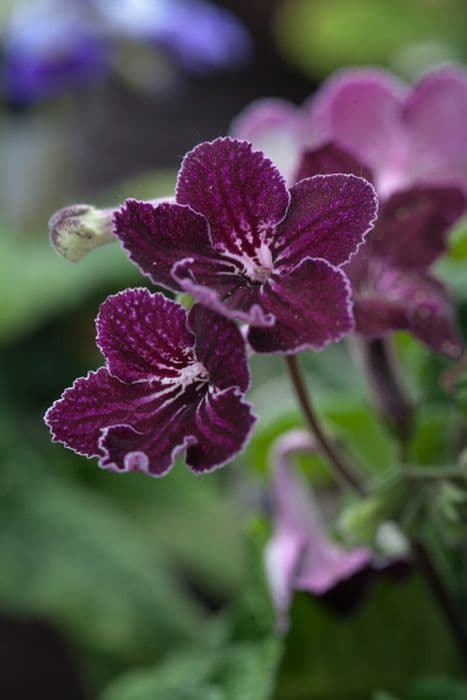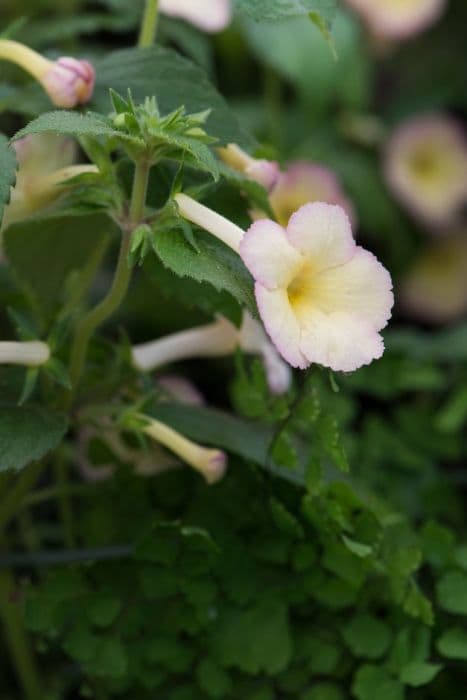Cape Primrose Streptocarpus 'Burgundy Ice'

ABOUT
The Streptocarpus 'Burgundy Ice', commonly known as Cape Primrose, is a strikingly beautiful ornamental plant that boasts attractive foliage and vibrant blooms. The plant typically has velvety, deep green leaves that are elongated and textured with prominent veining, creating a lush backdrop for its flowers. The flowers are the standout feature of this variety, presenting a dramatic array of hues in the burgundy spectrum. Each bloom has a trumpet-like shape with a flared mouth, showcasing petals that graduate from a deep, almost black, burgundy at the edges to a lighter, frosted burgundy towards the center. The petal surfaces may have a velvety sheen or a slightly iridescent quality, adding to the "ice" aspect of its name. Interspersed among the leaves, the blooms grow in clusters on slender, gracefully arching stems. The contrast between the dark, sumptuous tones of the flowers and the fresh green of the leaves creates a luxurious appearance that is eye-catching in any indoor or shaded garden space. The overall impression of the Cape Primrose 'Burgundy Ice' is one of elegance and sophisticated color, making it a popular choice among plant enthusiasts for adding a touch of floral opulence to their collection.
About this plant
 Names
NamesFamily
Gesneriaceae.
Synonyms
Cape Primrose, African Violet.
Common names
Streptocarpus 'Burgundy Ice'
 Toxicity
ToxicityTo humans
Streptocarpus 'Burgundy Ice', commonly known as Cape primrose, generally is not considered toxic to humans. However, as with any non-food plant, some individuals may experience mild reactions or allergies if they ingest parts of this plant. It's always advisable to keep ornamental plants out of the reach of children, who might ingest plant material out of curiosity. Ingesting this plant is unlikely to cause significant symptoms of poisoning, but it is not intended for consumption, so ingestion could potentially cause mild gastrointestinal upset due to the plant's non-edible nature.
To pets
Cape primrose is not listed as toxic to pets by the ASPCA or other major animal welfare organizations. While it is always best to prevent pets from eating houseplants, ingestion of this plant is unlikely to cause more than mild gastrointestinal upset in animals such as cats and dogs. If your pet consumes a significant amount of this plant and you notice symptoms such as vomiting or diarrhea, it is recommended to consult with your veterinarian.
 Characteristics
CharacteristicsLife cycle
Perennials
Foliage type
Evergreen
Color of leaves
Green
Flower color
Burgundy
Height
1 foot (30 cm)
Spread
1 foot (30 cm)
Plant type
Herb
Hardiness zones
10
Native area
Africa
Benefits
 General Benefits
General Benefits- Easy to care for: Streptocarpus 'Burgundy Ice' is relatively low maintenance, making it suitable for beginners.
- Long blooming period: This variety produces flowers for an extended period, which can add lasting color to indoor spaces.
- Compact growth: Its compact size is ideal for small spaces such as windowsills or tabletops.
- Aesthetic appeal: With its striking burgundy flowers, it provides an elegant visual interest to home decor.
- Versatile display: Can be used in various settings, including hanging baskets, plant stands, or as a bedding plant if suitable climate permits.
 Medical Properties
Medical PropertiesThis plant is not used for medical purposes.
 Air-purifying Qualities
Air-purifying QualitiesThis plant is not specifically known for air purifying qualities.
 Other Uses
Other Uses- Artistic inspiration - Streptocarpus 'Burgundy Ice', with its vibrant colors and patterns, may inspire artists and photographers who specialize in botanical themes, using the plant as a model for paintings, drawings, or photographic compositions.
- Theme gardens - This plant can be used to create a 'wine' themed garden due to its 'Burgundy Ice' name, accompanying other plants with similar wine-referencing names or colors.
- Color therapy spaces - The rich burgundy color of the Streptocarpus 'Burgundy Ice' can be incorporated into color therapy gardens, which are designed to create spaces for relaxation and stress relief through the use of color.
- Education - Schools and educational programs can use the Streptarpus 'Burgundy Ice' to teach students about plant growth, hybridization, and the care of flowering houseplants.
- Seasonal decor - The distinctive color of the Streptocarpus 'Burgundy Ice' provides an alternative to traditional reds and greens for holiday decorating, especially suitable for a more modern aesthetic.
- Crafting - The unique leaves and blooms of the plant can be used in crafting, for example, in making botanical prints or in pressing flowers for use in art and decoration.
- Floral arrangements - The long-lasting flowers of Streptocarpus 'Burgundy Ice' can be a striking addition to cut floral arrangements and used as an eye-catching centerpiece.
- Boutonnieres and corsages - The blossoms of the plant may be used in creating unique and non-traditional boutonnieres and corsages for special events.
- Insectary gardens - Although not a common use, some gardeners might integrate Streptocarpus 'Burgundy Ice' within insectary gardens to attract and support beneficial insects, given its attractive flowers.
- Ethnobotanical research - Streptocarpus 'Burgundy Ice', as a member of the diverse Streptocarpus genus, can be studied in terms of its cultural significance to people who traditionally utilize these plants in non-medicinal ways.
Interesting Facts
 Feng Shui
Feng ShuiThe Cape Primrose is not used in Feng Shui practice.
 Zodiac Sign Compitability
Zodiac Sign CompitabilityThe Cape Primrose is not used in astrology practice.
 Plant Symbolism
Plant Symbolism- Persistence: Streptocarpus, commonly known as Cape Primrose, can symbolize persistence due to its ability to thrive with minimal care once established.
- Resilience: As a plant that can adapt to various light conditions, the Cape Primrose denotes resilience and the ability to withstand changing environments.
- Long-lasting beauty: With its potential for a long blooming period, the Cape Primrose symbolizes enduring beauty or long-lasting affection.
- Hope: The bright and varied colors of the Cape Primrose flowers are often associated with hope and optimism for the future.
 Water
WaterCape Primrose should be watered thoroughly until the water runs out of the bottom of the pot, but always allow the top inch of soil to dry out before watering again. Generally, this equates to watering once a week, but this may vary depending on environmental conditions such as temperature and humidity. During its active growth in spring and summer, it may need more water—up to 16 ounces per week. In the cooler months, reduce watering to every two weeks or when the soil is dry to the touch. Always use room temperature water to avoid shocking the plant’s roots.
 Light
LightCape Primrose prefers bright, indirect light for optimal growth. It should be placed in a location where it can receive plenty of light without being exposed to the harsh rays of the midday sun, such as near an east or north-facing window. Avoid placing it in full, direct sunlight as this can scorch the leaves and cause damage to the plant.
 Temperature
TemperatureCape Primrose thrives in temperatures between 60 and 70 degrees Fahrenheit but can tolerate a range from about 50 to 80 degrees Fahrenheit. Keep the plant away from drafts and sudden temperature changes to prevent stress. The ideal environment mimics its native tropical habitat, so maintaining consistent warmth within its tolerance range is key for its health and vitality.
 Pruning
PruningCape Primrose benefits from regular pruning to remove dead or yellowing leaves and to encourage bushier growth. Pruning is best done after the plant finishes blooming, usually in late summer or early fall. Pinch back or cut any long, leggy stems to maintain a compact shape and a more aesthetically pleasing appearance. Remove spent flowers to promote further blooming.
 Cleaning
CleaningAs needed
 Soil
SoilThe best soil mix for Cape Primrose is a well-draining potting mix with perlite or vermiculite. The ideal pH range should be slightly acidic to neutral, between 5.8 to 6.5.
 Repotting
RepottingCape Primrose should be repotted every 1-2 years or when the plant outgrows its pot, ensuring fresh soil and space for growth.
 Humidity & Misting
Humidity & MistingCape Primrose thrives at moderate to high humidity levels, ideally between 50% to 70%.
 Suitable locations
Suitable locationsIndoor
For Cape Primrose, provide bright indirect light and consistent moisture.
Outdoor
Shelter Cape Primrose from direct sun and heavy rain.
Hardiness zone
Cape Primrose is hardy in USDA zones 10-11.
 Life cycle
Life cycleCape Primrose 'Burgundy Ice' begins its life cycle as a seed which, when sown in fertile, well-draining soil and provided with warmth and light, will germinate. Upon germination, it develops into a seedling with its first set of true leaves, indicating the start of the vegetative growth stage where the plant matures in size and foliage. During its growing season, proper watering, and indirect lighting encourage lush, verdant growth. After a period of vegetative growth, it enters the flowering stage, producing its distinctive burgundy, velvety flowers, provided it receives adequate light and is well-cared for. Post pollination, the flowers will fade, and seed pods may develop if the flowers have been successfully pollinated. Once mature, the plant will either continue to live and enter a dormant phase during the cooler, less light-abundant months or, if it is a biennial variety, may die back after setting seed, completing its life cycle.
 Propogation
PropogationPropogation time
Spring-Early Summer
Streptocarpus 'Burgundy Ice', commonly known as Cape Primrose, can be propagated effectively through leaf cuttings—a popular method among enthusiasts due to its simplicity and effectiveness. To propagate by this method, a healthy, mature leaf is selected and cut across the width into sections, each section being around 2 to 3 inches (5 to 7.5 cm) long. The cuttings are then placed directly into a moist potting mix, ensuring that the cut edge is in contact with the soil. It's important to maintain a humid environment for the cuttings, which can be achieved by covering the pot with a plastic bag or using a propagator. Roots and new growth typically appear within a few weeks to a couple of months, at which point the new plants can be potted on separately. This method is usually done in spring to early summer when the plant is actively growing, allowing the cuttings the best chance to take root and thrive.









